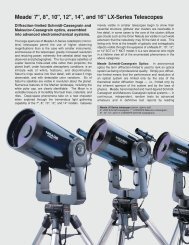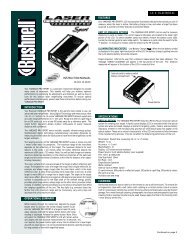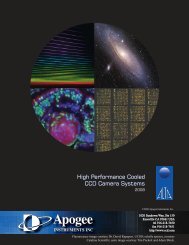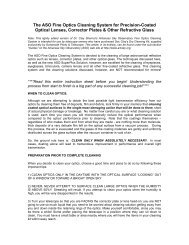INSTRUCTION MANUAL
INSTRUCTION MANUAL
INSTRUCTION MANUAL
You also want an ePaper? Increase the reach of your titles
YUMPU automatically turns print PDFs into web optimized ePapers that Google loves.
Finding the North Celestial Pole<br />
In each hemisphere, there is a point in the sky around which all the other stars appear to rotate. These<br />
points are called the celestial poles and are named for the hemisphere in which they reside. For example, in<br />
the northern hemisphere all stars move around the north celestial pole. When the telescope's polar axis is<br />
pointed at the celestial pole, it is parallel to the Earth's rotational axis.<br />
Figure 7-3 –<br />
The position of the Big Dipper<br />
changes throughout the year<br />
and the night.<br />
Many methods of polar alignment require that you know how to find the<br />
celestial pole by identifying stars in the area. For those in the northern<br />
hemisphere, finding the celestial pole is not too difficult. Fortunately, we<br />
have a naked eye star less than a degree away. This star, Polaris, is the<br />
end star in the handle of the Little Dipper. Since the Little Dipper (technically<br />
called Ursa Minor) is not one of the brightest constellations in the sky, it may<br />
be difficult to locate from urban areas. If this is the case, use the two end<br />
stars in the bowl of the Big Dipper (the pointer stars). Draw an imaginary line<br />
through them toward the Little Dipper. They point to Polaris (see Figure 7-4).<br />
The position of the Big Dipper changes during the year and throughout the<br />
course of the night (see Figure 7-3). When the Big Dipper is low in the sky<br />
(i.e., near the horizon), it may be difficult to locate. During these times, look<br />
for Cassiopeia (see Figure 7-4). Observers in the southern hemisphere are<br />
not as fortunate as those in the northern hemisphere. The stars around the<br />
south celestial pole are not nearly as bright as those around the north. The<br />
closest star that is relatively bright is Sigma Octantis. This star is just within<br />
naked eye limit (magnitude 5.5) and lies about 59 arc minutes from the pole.<br />
Definition<br />
The north celestial pole is the point in the northern hemisphere around which all stars<br />
appear to rotate. The counterpart in the southern hemisphere is referred to as the south<br />
celestial pole.<br />
Figure 7-4<br />
The two stars in the front of the bowl of the Big Dipper point to Polaris which is less than one<br />
degree from the true (north) celestial pole. Cassiopeia, the “W” shaped constellation, is on the<br />
opposite side of the pole from the Big Dipper. The North Celestial Pole (N.C.P.) is marked by<br />
the “+” sign.<br />
39
















